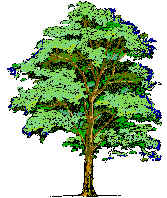
Biodiversity and Conservation - continued
previous

In Situ Conservation - within the natural habitat |
(Habitat or species-based) Protected sites, or Reserves In situ conservation maintains not only the genetic diversity of species, but also the evolutionary adaptations that enable them to adapt continually to shifting environmental conditions, such as changes in pest populations or climate. In situ conservation also ensures that along with target species, a host of other interlinked species are also preserved as a by-product. It is generally cheaper than ex situ methods (although not cheap). It may often be the only conservation option, for example for species with recalcitrant seeds. In situ conservation measures involve designating specific areas as protected sites. Protection may be offered at various levels, from complete protection and restriction of access, through various levels of permitted human use. In practice, complete protection is rarely necessary or advisable in a terrestrial context. Human beings have been a major part of the landscape for many thousands of years. Over the course of that time, human cultures have emerged and adapted to the local environment, discovering, using and altering biotic resources. Many areas that now appear ‘natural’ bear the hallmarks of millennia of human influence. Other species have evolved along with that influence and in many cases require the disturbance provided by humans to provide the necessary conditions for their survival. In other words, it is rarely advisable to relegate the countryside to the status of a museum piece. This applies particularly in the less economically developed areas of the world, where in many cases, the livelihood of the local people depends on using the natural resources available to them. Prohibiting the use of such resources in protected areas means that expensive enforcement measures usually have to be put in place. It is far better to involve local people in conservation and to find creative ways for them to make a sustainable living while still protecting valuable habitats or species. The biosphere reserve concept has been developed through the Man and Biosphere (MAB) Programme of the United Nations Educational, Scientific and Cultural Organisation (UNESCO). Biosphere reserves are an attempt to reconcile the problems of conserving biodiversity and biological resources, with sustainable use of natural resources for people. They form an international network of sites, nominated by national governments, but designated by UNESCO. The first reserves were nominated as long ago as 1976. By 2001, a network of 393 reserves in 94 countries had been developed. More on Biosphere reserves here. Marine conservation areas lag behind terrestrial ones. Protected areas have existed on land for over a century, but there is no tradition of managing marine areas for conservation. The only current statutory marine reserve in England is Lundy Island. This harbours a huge variety of marine life due to the diversity of underwater habitats present there. |
 |
Marine reserves may be vital tools in preserving species-rich areas such as tropical coral reefs, which are being devastated by non-sustainable fishing methods in many areas. The rationale of such reserves is not to lock away fish from fishermen, but rather to create refuges inside which populations can build up and spill over to repopulate adjacent areas. |
| Marine Reserves need to be carefully designed to take into account,
movement patterns, dispersal rates and population dynamics of particular target species.
For example, it would be pointless having a reserve where the resident species regularly
travelled to non-protected areas. It would also be pointless protecting the habitat of an
adult, but neglecting the geographically different breeding grounds and habitats of
juveniles, or vice versa. Such factors should also be taken into consideration in the
design of terrestrial reserves. Management of Nature Reserves Nature reserves are usually designated to protect a particular species, assemblage of species, or specific habitats. As such they can rarely be left in isolation to manage themselves. Management is necessary in order to prevent natural processes such as succession from taking place. Such resulting changes in habitat may mean the loss of particular species for which the reserve was originally designated.Succession is a natural process which will tend to replace particular species with different ones. This is often as a result of ecological change induced by the organisms themselves. In former times, while an area of a particular habitat might be lost through succession (such as a wetland drying out and eventually becoming a woodland), there would always be other wetland habitats at an earlier stage of the succession process elsewhere. These would act as species reservoirs. With the drastic loss of area of natural habitat occurring world-wide, this is often no longer the case. The decision therefore has to be made to halt succession at a particular stage in order to preserve the species associated with it. Examples of this include wild flower meadows, wetlands and heathlands. |
|
RESTORATION |
|
 |
Restoration attempts to bring land modified by human use back to its original state. Because determining the original natural state is often difficult and because ecosystems continually change, this is rarely a realistic goal. Changes may also in some cases be irreversible, so that restoration to an original condition is not an option. For these reasons, restoration is often limited to the approximate recreation of habitat. |
| Restoration does not necessarily require intervention. Left to natural processes, many ecosystems will return to their original condition provided populations of the original species still exist nearby. This may however be a lengthy process. In Brazil’s caatinga forest, natural recovery of slash and burn agricultural sites takes more than a century. Sites cleared by bulldozer may take a thousand or more years to recover. Intervention may be used to speed up the process. It becomes vital where an ecosystem will never recover naturally, either because it has been physically transformed, or because species cannot migrate to repopulate the area. Restoration may rely heavily upon species maintained by ex situ methods and is an example of the complementary nature of in situ and ex situ techniques. | |
RECOVERY OF THREATENED SPECIES |
|
| The recovery of threatened species generally hinges on providing suitable
habitat and conditions in which they can thrive. Most biodiversity losses can be directly
attributed to habitat loss, so provision of habitat is often the key requirement for
recovery of a species. The dormouse (Muscardinus avellanarius)is a good example of
this.Dormice
are the subject of a species recovery program sponsored by English Nature. They thrive
in deciduous woodland and overgrown hedgerows. They are arboreal and require networks of
interlinking low branches to provide aerial highways to food sources (e.g. hazel nuts and
honeysuckle). In former times, the practice of coppicing woodland (cutting trees near to
ground level and then allowing them to regenerate numerous shoots) provided ideal
conditions for dormice. However, coppicing is little practised these days, with the result
that large areas of former habitat have become unsuitable for dormice. Recovery therefore
hinges on providing suitable areas for the species.
Dormice also suffer from competition with an introduced species, the grey squirrel. Both species compete for the food resource of hazel nuts. |
|
INTRODUCED SPECIES |
|
| The vast majority of exotic introduced species die out because they are
unsuited to local conditions. A few however, appear to be superbly adapted to particular
local conditions and will tend to out-compete native species.Regulatory policies are necessary to curb the introduction of
exotic species and genetic resources, as the consequences can be disastrous. Introduced
species can wipe out innumerable other local species. Between 1967 and 1972, an African
cichlid fish introduced into a lake in Panama wiped out 6 of the 8 previously common fish
species, drastically reduced populations of a seventh and affected aquatic invertebrates,
algae and fish-eating birds up and down the food chain.
In Britain, particularly in the west, rhododendron has taken over large areas, virtually eliminating native plants and their associated faunas. This one species alone has decimated tens of thousands of acres. Grey squirrels introduced from America have also all but replaced native red squirrel populations. Even introducing the same species can present hazards through the mixing of genetic stocks. Fish populations can be contaminated by interbreeding with introduced varieties. The genetic integrity of native British Red Deer is now also threatened through hybridisation with introduced Sika Deer. Pure Red Deer may in the end be confined to isolated islands in Scotland. |
|
| GENETIC MODIFICATION | |
| Humans now have the technology to alter life on earth in a totally unique way. Genetic engineering can involve the transfer of genetic material between widely separated taxonomic groups. e.g. Genes from a fish have been introduced into tomatoes. Entirely new species can intentionally or unintentionally be produced. There is no guarantee that all the results will be beneficial or can even be controlled. | |
LEGAL PROTECTION |
|
 Nature reserves need to be
properly protected from the adverse results of human activity. This might be indirect, as
in for example, habitat degradation through pollution brought about by activities
elsewhere. Alternatively, it may involve direct damage, as in unauthorized extraction of
resources from the reserve. Such protection requires the presence of a legal framework
which can be effectively enforced. Nature reserves need to be
properly protected from the adverse results of human activity. This might be indirect, as
in for example, habitat degradation through pollution brought about by activities
elsewhere. Alternatively, it may involve direct damage, as in unauthorized extraction of
resources from the reserve. Such protection requires the presence of a legal framework
which can be effectively enforced.
|
|
Copyright 2003 Dr Barbara Corker